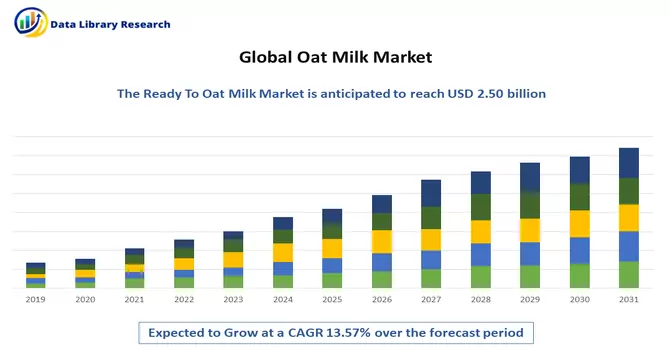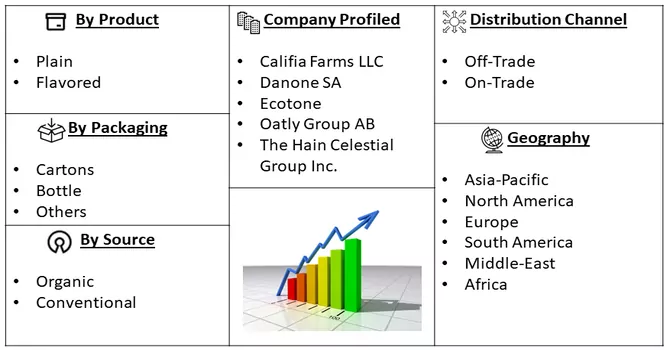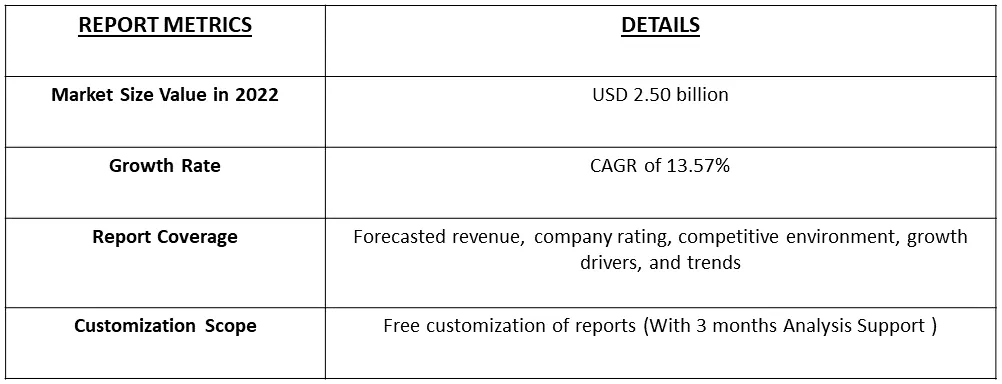The Oat Milk Market size is estimated at 2.50 billion USD in 2022, registering a CAGR of 13.57% during the forecast period (2023-2030).

Get Complete Analysis Of The Report - Download Free Sample PDF
Oat milk is a plant-based, dairy-free milk substitute made from whole oat grains. It is created by blending oats with water, and often, additional ingredients such as sweeteners, salt, and vitamins. The mixture is then strained to remove solid particles, resulting in a smooth, creamy liquid that resembles traditional cow's milk in color and texture.
Oat milk's growing popularity can be attributed to a confluence of health-related factors such as milk allergies, lactose intolerance, and concerns about obesity. Additionally, its sustainability and allergen-free characteristics make it a suitable choice for those with dietary restrictions and environmentally conscious consumers. Moreover, the health benefits offered by oats milk is also contributing to the market growth.
Market Segmentation: The Oat Milk Market is segmented by Distribution Channel (Off-Trade, and On-Trade) and by Region (Africa, Asia-Pacific, Europe, Middle East, North America, and South America). Market Value in USD and Volume are both presented. Key Data Points observed include Per capita consumption; Population; and Production volume of plant-based products.

For Detailed Market Segmentation - Download Free Sample PDF
Oat milk has gained substantial popularity driven by a confluence of factors that include the rising prevalence of milk allergies, a growing lactose-intolerant population, and evolving consumer preferences for sustainable, low-fat, and allergen-free dietary choices. Oat milk ranks as the second most-consumed plant milk among individuals attempting to manage their weight or those seeking lactose-free alternatives. Its nutritious profile and versatility make it a favored option.
Market Drivers :
Increasing Prevalence of Milk Allergies and Lactose Intolerance
The increasing prevalence of milk allergies and lactose intolerance has significantly impacted dietary choices, leading to a surge in demand for dairy alternatives like oat milk. This trend is reshaping the food industry, prompting innovation and improvements in allergen management and labeling. As consumer awareness of these conditions grows, the market for dairy alternatives is expected to continue expanding, providing options for individuals seeking to address their dietary challenges and adopt plant-based, allergen-free, and lactose-free diets. The increasing prevalence of milk allergies and lactose intolerance has fueled the popularity of dairy alternatives, such as oat milk, almond milk, and soy milk. These alternatives offer a suitable choice for individuals seeking relief from digestive discomfort or allergenic reactions. Thus, due to the above-mentioned reasons the market is expected to witness significant growth over the forecast period.
Increasing Health Benefits
Oat milk's increasing recognition for its health benefits has made it a favored choice among consumers seeking dietary options that promote heart health, cater to specific dietary considerations, and support weight management. Its nutritional value, allergen-free nature, and eco-friendly production have contributed to its growing popularity in the health-conscious and environmentally aware-consumer landscape. Oat milk's versatility further enhances its appeal, as it can be used in a variety of culinary applications, making it a well-rounded option for those who value both health and taste in their dietary choices. Thus, due to the above-mentioned reasons the market is expected to witness significant growth over the forecast period.
Market Restraints :
High Cost of Cost Oats Milk
The higher cost of oat milk is influenced by various factors, including oat quality, production processes, packaging, and branding. Thus, this may be less affordable for some consumers, but it also contributes to oat milk's premium image and appeals to those who prioritize factors like sustainability and dietary considerations.
The COVID-19 pandemic impacted the demand for oat milk by driving health-conscious choices, reducing dairy consumption, and increasing reliance on e-commerce for grocery needs. Oat milk's nutritional benefits, versatility, and alignment with sustainability preferences made it a favorable choice among consumers adapting to new dietary preferences and lifestyle changes brought about by the pandemic. This shift in consumer behavior contributed to the continued growth of the oat milk market during challenging times. Thus, the oats milk demand increased significantly increased over the forecast period.
Segmental Analysis
Off-Trade Distribution Channel is Expected to Witness Significant Growth Over the Forecast Period
Distribution channels are pivotal in the global sales of oat milk, catering to the diverse preferences and needs of consumers. Off-trade distribution channels like supermarkets and hypermarkets offer consumers a diverse array of plant-based milk options from various brands, allowing them to choose according to their dietary preferences and specific requirements. For instance, as per the Economic Times reported that in 2022, supermarkets and hypermarkets accounted for 66% of the value share. These retail chains offer an inviting place for consumers to shop, allowing them to choose from several plant-based milk options provided by various companies, depending on their needs. Thus, the segment is expected to witness significant growth over the forecast period.
North America Region is Expected to Witness Significant Growth Over the Forecast Period
North America's oat milk market is characterized by the increasing preference for dairy alternatives, driven by lactose intolerance, milk allergies, and health-conscious choices. The region's focus on sustainability and its commitment to plant-based dietary trends further fuel the consumption of oat milk. Oat milk has positioned itself as a versatile, nutritious, and eco-friendly option that caters to the evolving dietary preferences of North American consumers. Its availability across various retail channels enhances its accessibility, contributing to the growing trend in the region.
The region, particularly the United States, has been grappling with obesity concerns. For instance, in the 2022, Obesity Atlas, as of November 2021, the adult obesity prevalence was 30% or higher in the United States, with 19 states recording an obesity prevalence of 35% or more. Oat milk, with its low-fat and health-conscious image, is seen as a suitable alternative to traditional dairy milk. Similarly, in the United States alone, between 30-50 million consumers were found to be lactose-intolerant in 2022. Oat milk, being dairy-free, has become an appealing choice for this growing demographic.
The growing plant-based dietary trend in North America has led to an uptick in the consumption of oat milk. Consumers value plant-based options for their health benefits and the reduced environmental footprint they offer. Thus, due to the above-mentioned reasons the region is expected to witness significant growth over the forecast period.

Get Complete Analysis Of The Report - Download Free Sample PDF
The Oat Milk Market is moderately consolidated. The major players in this market are:
Recent Developments:
1. September 2022: Elmhurst launched its reformulated unsweetened Oat Milk with enhanced nutritional benefits. The new formula includes more calcium, healthy fat, and potassium than the prior Elmhurst Oat Milk.
2. June 2022: Elmhurst 1925 announced the launch of three products, including Chocolate Milked Oats and Unsweetened Milked Oats, across all Whole Foods Market chain locations.
Q1. What was the Oat Milk Market size in 2022?
The Oat Milk Market size is estimated at 2.50 billion USD in 2022.
Q2. At what CAGR is the market projected to grow within the forecast period?
Oat Milk Market is registering a CAGR of 13.57% during the forecast period.
Q3. What are the factors driving the Oat Milk Market?
Key factors that are driving the growth include the Increasing Prevalence of Milk Allergies and Lactose Intolerance and Increasing Health Benefits
Q4. Which region has the largest share of the Oat Milk Market? What are the largest region's market size and growth rate?
North America has the largest share of the market. For detailed insights on the largest region's market size and growth rate request a sample here
Data Library Research are conducted by industry experts who offer insight on industry structure, market segmentations technology assessment and competitive landscape (CL), and penetration, as well as on emerging trends. Their analysis is based on primary interviews (~ 80%) and secondary research (~ 20%) as well as years of professional expertise in their respective industries. Adding to this, by analysing historical trends and current market positions, our analysts predict where the market will be headed for the next five years. Furthermore, the varying trends of segment & categories geographically presented are also studied and the estimated based on the primary & secondary research.
In this particular report from the supply side Data Library Research has conducted primary surveys (interviews) with the key level executives (VP, CEO’s, Marketing Director, Business Development Manager and SOFT) of the companies that active & prominent as well as the midsized organization
FIGURE 1: DLR RESEARH PROCESS

Extensive primary research was conducted to gain a deeper insight of the market and industry performance. The analysis is based on both primary and secondary research as well as years of professional expertise in the respective industries.
In addition to analysing current and historical trends, our analysts predict where the market is headed over the next five years.
It varies by segment for these categories geographically presented in the list of market tables. Speaking about this particular report we have conducted primary surveys (interviews) with the key level executives (VP, CEO’s, Marketing Director, Business Development Manager and many more) of the major players active in the market.
Secondary ResearchSecondary research was mainly used to collect and identify information useful for the extensive, technical, market-oriented, and Friend’s study of the Global Extra Neutral Alcohol. It was also used to obtain key information about major players, market classification and segmentation according to the industry trends, geographical markets, and developments related to the market and technology perspectives. For this study, analysts have gathered information from various credible sources, such as annual reports, sec filings, journals, white papers, SOFT presentations, and company web sites.
Market Size EstimationBoth, top-down and bottom-up approaches were used to estimate and validate the size of the Global market and to estimate the size of various other dependent submarkets in the overall Extra Neutral Alcohol. The key players in the market were identified through secondary research and their market contributions in the respective geographies were determined through primary and secondary research.
Forecast Model
